Introduction
Nearly 8007 species of amphibians and about 10 793 species of reptiles are recognized worldwide, and of these, 828 amphibians and 618 reptiles are distributed in Colombia (Acosta-Galvis, 2019; AmphibiaWeb, 2019; Frost, 2019; Uetz et al., 2019). In 2004, 139 species of amphibians and 188 species of reptiles were known to occur in the Choco biogeographic region of Colombia (Castaño-Mora et al., 2004; Lynch & Suárez-Mayorga, 2004). However, since 2005, the number of amphibians and reptiles recorded has increased substantially for this region to 157 amphibians and 215 reptiles (Ayerbe-González & López-López, 2005; Heyer, 2005; Passos et al., 2009; Poe et al., 2009; Rengifo & Rentería-Moreno, 2011; Cadle, 2012; Grant & Myers, 2013; Palacios-Rodríguez et al., 2013a, 2013b; Jaramillo-Martínez et al., 2015; Ospina-Sarria et al., 2015; Sánchez-Pacheco et al., 2016; Márquez et al., 2017; Angarita-Sierra & Lynch, 2017; Grant et al., 2017; Rada et al., 2017; Medina-Rangel et al., 2018a, 2018b; Pinto-Erazo & Medina-Rangel, 2018, Grisales-Martínez & Rendón-Valencia, 2019) representing ca. 19 % and 35 % of the richness of Colombian amphibians and reptiles, respectively.
According to Lynch & Suárez-Mayorga (2004), the northern Chocó of Colombia harbors the greatest richness of amphibians in this biogeographic region, and the reduced richness in southern Chocó (in Cauca and Nariño departments) is perhaps a consequence of the few available records in museum collections, and inventory publications. Particularly for Nariño, there are two published species list of amphibians and reptiles from the lowlands (Salaman, 1994; Mueses-Cisneros & Moreno-Quintero, 2012). Likewise, the species descriptions and range extensions are fewer for this department (ca. 15 publications) in comparison with the northern portion of the colombian Choco biogeographic region (>30 publications) (Acosta-Galvis, 2019; Amphibiaweb, 2019; Frost, 2019; Uetz et al., 2019).
Here we present a preliminary list and a diversity study of the amphibian and reptile fauna of the municipalities of Tumaco and Francisco Pizarro, department of Nariño, Colombia, based on field work, museum records and biodiversity databases, for characterizing and documenting the amphibians and reptiles from southwestern Colombia.
Materials and methods
Study area.
Fieldwork was carried out in the municipalities of Tumaco and Francisco Pizarro, Nariño, Colombia (Figure 1). Four localities were sampled in Tumaco (numbers 1-4 in Table 1) and five localities in Francisco Pizarro (numbers 5-9 in Table 1).
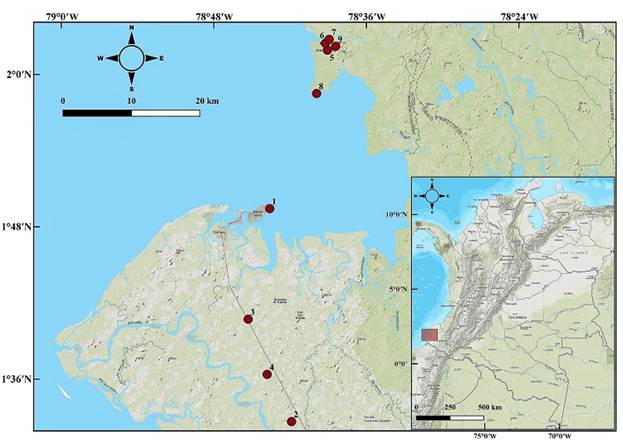
Figure 1 Sampling sites for herpetofauna in Tumaco (1-4) and Francisco Pizarro (5-9), Nariño, Colombia.
Table 1 Localities sampled for herpetofauna in Tumaco (1-4) and Francisco Pizarro (5-9), Nariño, Colombia.
| # Site | Sites of sampling | Latitude | Longitude |
|---|---|---|---|
| 1 | Dirección General Marítima station (DIMAR) | 1°49´25.82´´N | 78°43´35.90´´W |
| 2 | Corporación Colombiana de Investigación Agropecuaria (CORPOICA) | 1°32´39´´N | 78°41´53´´W |
| 3 | Mar Agrícola station | 1°40´42.89´´N | 78°45´17.96´´W |
| 4 | Universidad Nacional de Colombia, Sede Tumaco | 1°36´22.10´´N | 78°43´48.16´´W |
| 5 | Empresa embotelladora de Agua and El Palmichal | 2°01´54.94´´N | 78°39´03.83´´W |
| 6 | La Primavera farm | 2°02´27.48´´N | 78°39´13.04´´W |
| 7 | Neighborhood of the sanitary landfill | 2°02´46.16´´N | 78°38´55.27´´W |
| 8 | Isla del Gallo | 1°58´30.09´´N | 78°39´54.66´´W |
| 9 | Bosque del Acueducto | 2°02´13.21´´N | 78°38´24.59´´W |
Sampling methods. We visited the municipality of Tumaco four times: 5-14 March, and 6-14 September, 2015; 29 February-9 March, and 5-12 September, 2016; and the municipality of Francisco Pizarro during 15-16 September, 2015; 1-9 March, and 3-4 September, 2016. We captured amphibians and reptiles through active searching in both Franciso Pizarro and Tumaco, and only in Tumaco did we use pitfall traps with drift fences, which were installed in a “Y” array with four buckets at the end of fences and were checked every other day (Crosswhite, 1999). Active searching was carried out during the day (09:00-12:00 h) and during the night (18:00-21:00 h) using the VES (Visual Encounter Survey) methodology, for a total sampling effort of 1604 hours.person-1.
Collected specimens were euthanized with 2 % xylocaine, fixed in 10 % formaldehyde and preserved in 70 % ethanol (Pisani, 1973). Photographs and description of the coloration patterns were recorded for every individual. Additionally, the specimens were identified using Ayala & Castro (unpublished document), Peters & Orejas-Miranda (1970), Lynch (1976), Pérez-Santos & Moreno (1988), Campbell & Lamar (2004), Passos et al. (2009), MECN (2010), Harvey et al. (2012) and Arteaga et al. (2016).
We followed Frost (2019) and Uetz et al. (2019) as classification systems for amphibian and reptiles, respectively. All specimens were deposited in the amphibian and reptile collections of the Instituto de Ciencias Naturales (ICN), Universidad Nacional de Colombia (Appendix 1).
Database searching. To complement the species list we consulted the databases of GBIF (Global Biodiversity Information Facility), SIB (Biodiversity Information System of Colombia) and the biological collections of the Instituto de Ciencias Naturales. Additional information was obtained from Castaño-Mora et al. (2004) and Lynch & Suárez-Mayorga (2004).
Data analysis. By means of a rarefaction and an extrapolation curve (Chao et al., 2014), we estimated the species richness of amphibians and reptiles in the study area. The percentage of completeness (CM %) achieved by our inventory was estimated through sampling coverage curves, and the additional coverage that would be needed to reach the maximum number of species was also estimated. This analysis estimates the proportion of the total number of individuals in a community belonging to a species sampled (Chao & Jost, 2012). We used the iNEXT R package (Hsieh et al., 2016) with 1000 bootstraps to create 95 % confidence interval (CI).
Results
During fieldwork we recorded 1392 specimens of 68 species: 23 species of amphibians (991 individuals) and 46 species of reptiles (401 individuals). Amphibian species with the highest abundance were Epipedobates boulengeri (380), Scinax tsachila (131) and Rhinella horribilis (103). For reptiles, Basiliscus galeritus (74), Holcosus bridgesii (45), Anolis auratus (37), Dipsas gracilis (28) and Sibon nebulatus (24) were the most abundant species (Appendix 1). With the addition of the information obtained in databases and literature, species richness increases to 25 amphibians and 55 reptiles for both localities (Appendix 1, Figure 2 and 3). Amphibians are represented by 11 families and 18 genera in the orders Anura, Caudata, and Gymnophiona, and reptiles by 21 families and 24 genera in the orders Squamata (suborders Sauria and Serpentes), Testudines and Crocodylia.
The figures of amphibians and reptiles in Tumaco and Francisco Pizarro represent 16 % of the amphibians and 26 % of the reptiles recorded for the Chocó biogeographic region, and 3 % of the amphibians and 9 % of the reptiles recorded for Colombia (Castaño-Mora et al., 2004; Lynch & Suárez-Mayorga, 2004).
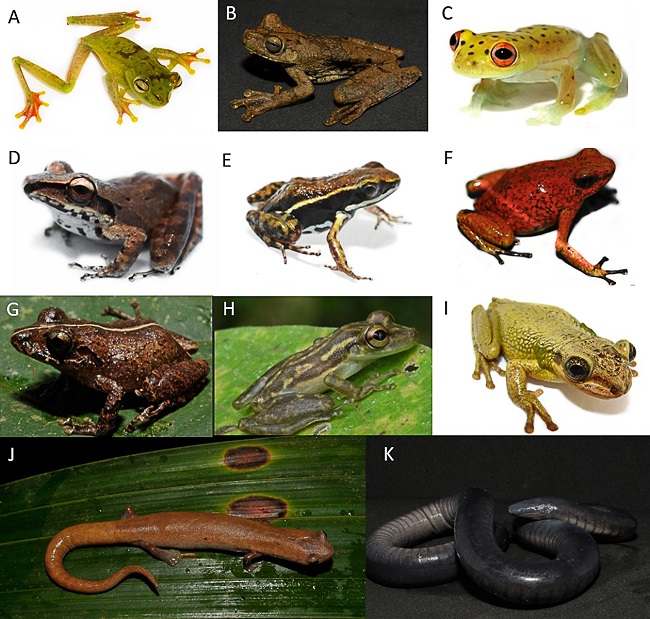
Photographs: Guido F. Medina-Rangel (B, E, F, G, J, K), María José Espejo (A, C, H, I) and Javier Ardila (D).
Figure 2 Some of the amphibian species reported in Tumaco and Francisco Pizarro, Nariño, Colombia. A, Boana pellucens; B, Boana rosenbergi; C, Cochranella litoralis; D, Craugastor longirostris; E, Epipedobates boulengeri; F, Oophaga sylvatica; G, Pristimantis walkeri; H, Scinax tsachila; I, Trachycephalus jordani; J, Bolitoglossa biseriata; K, Caecilia guntheri.
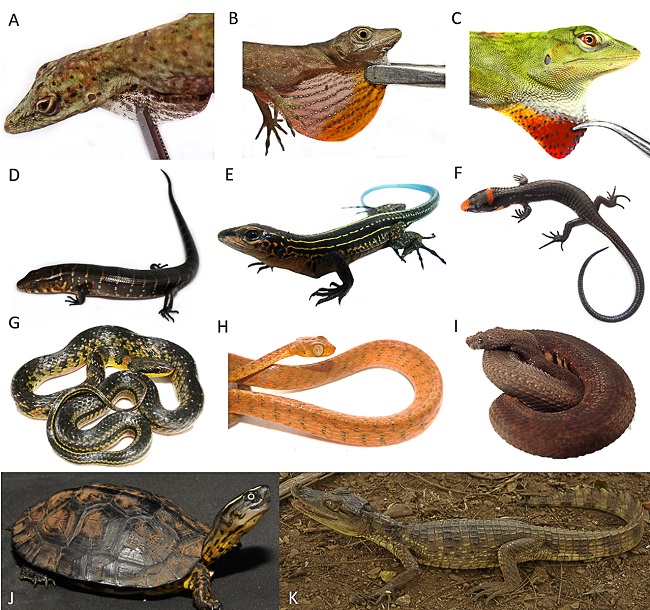
Photographs: Guido F. Medina-Rangel (B, D, G, J, K), Javier Ardila (C), María José Espejo (A, E, I), Martha Calderón (H) and María Alejandra Pinto-Erazo (F).
Figure 3 Some of the reptile species reported in Tumaco and Francisco Pizarro, Nariño, Colombia. A, Anolis festae; B, Anolis maculiventris; C, Anolis parvauritus; D, Diploglossus monotropis; E, Holcosus bridgesii; F, Ptychoglossus gorgonae; G, Erythrolamprus epinephelus; H, Imantodes inornatus; I, Trachyboa boulengeri; J, Rhinoclemmys melanosterna; K, Caiman crocodilus.
The amphibian families Hylidae (7 spp., 29 %) and Craugastoridae (4 spp., 17 %) had the highest diversity. In contrast, the families Aromobatidae, Centrolenidae, Eleutherodactylidae, Ranidae (order: Anura) and the family Caecilidae (order: Gymnophiona) registered the lowest diversity, each representing 4% of diversity, with one species. For reptiles, the families with the highest diversity were Colubridae (17 spp., 34 %) and Dactyloidae (10 spp., 20 %) within the order Squamata, and Geoemydidae (2 spp., 50 %) within the order Testudines. The order Crocodylia was represented only by one species. The families Corytophanidae, Diploglossidae, Hoplocercidae, Iguanidae, Phyllodactylidae, Teiidae, Tropiduridae, Elapidae, Tropidophiidae (order: Squamata), Cheloniidae and Kinosternidae (order: Testudines), and Alligatoridae (order: Crocodylia) also had one species each (Appendix 1, Figure 4).
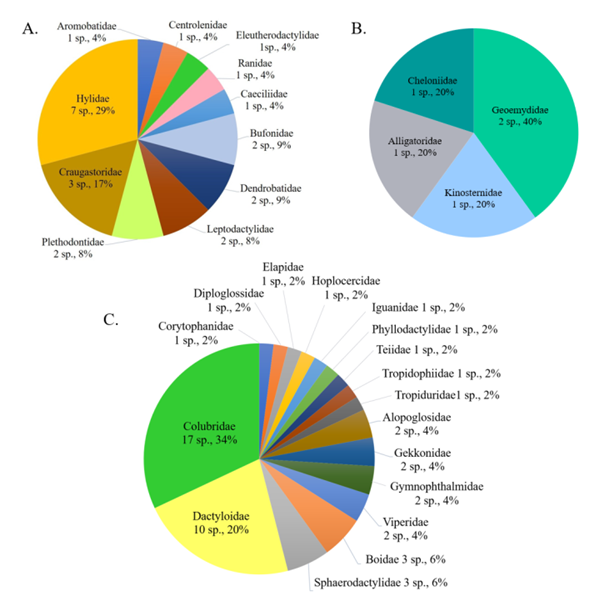
Figure 4 Number of species and richness percentage per family of amphibians and reptiles in Tumaco and Francisco Pizarro, Nariño, Colombia. A, Amphibia; B, Testudines and Crocodylia; C, Squamata.
On a global scale, the highest amphibian diversity is concentrated in the families Craugastoridae, with 832 species, followed by Hylidae, with 720 species (Frost, 2019). We found a similar trend, since both families contributed to the greatest number of species in the studied municipalities. In reptiles, the family Colubridae (1944 species) and the genus Anolis (family Dactyloidae, 429 species), are the most speciose taxa (Uetz et al., 2019), similar to the pattern of diversity found in our study.
The municipality of Tumaco had a higher number of species (51 species) than Francisco Pizarro (39 species). Tumaco had 29 exclusive species, while 18 species were found only in Francisco Pizarro. In the latter municipality, 39 species and 18 exclusive species were found.
In Tumaco, localities with the highest number of species were Mar Agrícola (32 spp.) and Universidad Nacional, Sede Tumaco (36 spp.), while there were 20 species in Dimar and 12 species in Corpoica. Despite the lower diversity found in these localities, species such as Diploglossus monotropis and Lepidodactylus lugubris were recorded exclusively in Dimar and Corpoica, respectively. The municipality of Francisco Pizarro, despite having a smaller number of species, had greater number of exclusive amphibian species than Tumaco (9 vs. 5) such as Pristimantis parvillus, P. walkeri and Caecilia guntheri.
Before this publication, and from the same fieldwork done in the region, we published some new records of reptile species for Colombia: Corallus blombergi (Pinto-Erazo & Medina-Rangel, 2018) and Anolis festae (Medina-Rangel et al. 2018a), both of them previously known only from Ecuador. Additionally, in this study we expand the distribution of Anolis auratus and Gonatodes albogularis. The former had been recorded up to the department of Valle del Cauca, and in the case of G. albogularis, up to Gorgona Island, department of Cauca (Castaño-Mora et al., 2004; Castro-Herrera et al., 2012). Records of these species correspond to the southernmost localities in the Chocó biogeographic region of Colombia.
Likewise, for amphibians we found new records for Colombia: Pristimantis walkeri (reported only in Ecuador, Arteaga et al., 2013) and Scinax tsachila (recently described and reported in Ecuador, Ron et al. (2018)). Moreover, Allobates talamancae, Dendropsophus ebraccatus and Scinax sugillatus, are new records for the department of Nariño (Acosta-Galvis, 2019).
Accumulation curves and sampling coverage.
According to our data, we estimated that up to 111 species, around 36 amphibians and 75 reptiles, can be found with a greater sampling effort when sampling coverage higher than 99 % is reached (Figure 5A).In amphibians, with 991 individuals, we obtained a sampling coverage of 98 %, and in reptiles, with 401 individuals, we found a sampling coverage of 95 % (Figure 5B). This inventory has shown slightly better richness results for amphibians than reptiles.
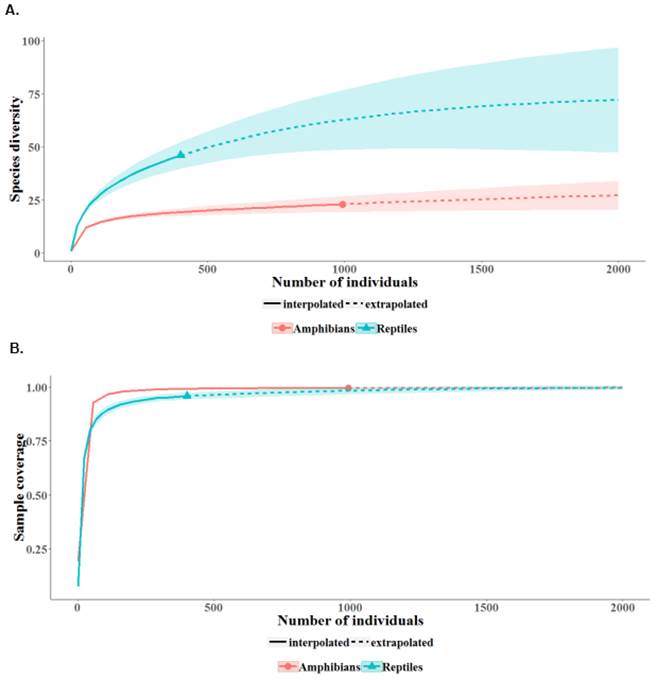
Figure 5 Richness and sampling coverage estimate for amphibians and reptiles from Tumaco and Francisco Pizarro, Nariño, Colombia. A, richness curves; B, Sampling coverage curves. Solid lines: data collected during inventory. Dashed lines: estimates or extrapolations. Shaded areas represent the confidence interval of 95 % generated by re-sampling (500 bootstraps).
Discussion
In comparison to the herpetofauna recorded for the province of Esmeraldas in Ecuador (MECN, 2010), adjacent to the southern lowlands of the department of Nariño, the municipalities of Tumaco and Salahonda have fewer species. The families Hemiphractidae, Microhylidae and Phyllomedusidae, found in Esmeraldas, were not present in our study. Similarly, within reptiles, of the 24 families recorded in Esmeraldas, two families of lizards (Gymnophthalmidae and Polychrotidae), one of amphisbaenids (Amphisbaenidae), two of snakes (Anomalepididae and Leptotyphlopidae) and one of turtles (Chelydridae) were not found in Tumaco and Salahonda. These differences can be due to methodologies focused on ground-dwelling-species (Amphisbaenidae, Gymnophthalmidae, Leptotyphlopidae, Microhylidae), and that some environments such as aquatic habitat (where Chelydridae species may be found) or canopy habitat (for Hemiphractidae and Phyllomedusidae species) were not sampled at all in this study. Therefore, more sampling effort will be needed to maximize encounter success of some taxa, although our sampling coverage was high for both amphibians and reptiles.
The study region has been classified as a hotspot for deforestation in Colombia, with a probability of 70 % of forest cover being converted to agricultural uses (Etter et al., 2006). This may partially explain, in addition to the lack of certain methodologies, why some of the forest fossorial or leaf litter reptile species were not observed in this study. The same reason can be claimed to explain the absence of some amphibian records in this region, particularly species of the families Hemiphractidae and Phyllomedusidae, which are closely associated with tall-tree vegetation, and are found vocalizing (e.g, members of the genera Agalychnis, Gastrotheca) or perching, in the canopy (e.g. Cruziohyla calcarifer) (Castro-Herrera & Vargas-Salinas, 2008; MECN, 2010; Palacios-Rodríguez et al., 2018). Furthermore, habitat fragmentation, agricultural development, and fumigation with chemicals are factors that reduce the population density of species like Gastrotheca cornuta in Cauca and Nariño (Coloma et al., 2008).
In the Colombian Chocó biogeographic region, most of the amphibian families have slightly high endemism values. Particularly, the family with the highest percentage of endemism is Plethodontidae, since 35 % of species are found only in this region (Lynch & Suárez-Mayorga, 2004). In reptiles, there are 127 endemic species for Colombia, and 30 occur exclusively in this region, representing a 24 % rate of endemism (Castaño-Mora et al., 2004). In this study we found 17 out of 25 species of amphibians and 27 out of 55 species of reptiles endemic for the Chocó Biogeographic region (Appendix 1). In consequence, this region is considered not only as a hotspot for deforestation in Colombia, but also as a hotspot for biodiversity and it acquires a significant relevance regarding the diversity and endemism of its fauna.















